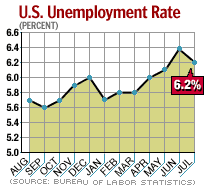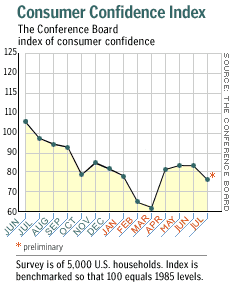NEW YORK (CNN/Money) -
Despite a recent wave of rosy reports on the U.S. economy and much optimism about the direction of growth, businesses still aren't hiring -- and some economists worry the labor-market slump could nip the recovery in the bud.
Employers cut 44,000 more jobs from their payrolls in July, the Labor Department said Friday, and the year-over-year change in payrolls has been negative for 25 straight months, the longest stretch since 1944-46.

This unhappy news came at a time when many other economic indicators have been pointing upward, and policy makers and economists have been promising prosperity is right around the corner.
Consumers, however, haven't been so convinced. They haven't exactly stopped spending -- they almost never do, in fact -- but their confidence has begun to falter, mainly because the labor market apparently still hasn't gotten the news that the latest recession ended in November 2001.
Some economists fear that If job growth doesn't appear relatively soon, consumers -- whose spending fuels more than two-thirds of the total economy -- could go into hibernation, resulting in Recession II.
"If the job market doesn't kick into higher gear soon, consumers will lose confidence and rein in their spending, and the economy will in all likelihood fall back into recession unless we're very lucky," said Mark Zandi, chief economist at Economy.com.
The problem of productivity
In typical business cycles, a return to economic growth leads eventually to a pickup in hiring. But the economy has been growing steadily since the end of 2001, while payrolls are still underwater and have been for more than two years, the longest stretch since World War II.

Some economists fear the labor market is a different sort of animal these days, meaning the old expectations about labor-market behavior could be wrong. For one thing, technological improvements have led to a staggering surge in productivity, meaning employers are able to milk much more work out of fewer workers.
That's great news for corporate profitability and economic growth, but of small consolation to the nine million people looking for work.
"The economy continues to grow with fewer people working, indicating that productivity gains are surging," said Sung Won Sohn, chief economist at Wells Fargo & Co. "How long can we squeeze juice out of this orange? Not indefinitely. Sooner or later economic growth would suffer."
And many businesses are moving operations overseas, where work and overhead costs -- including health care -- are cheaper. This is an ancient story in the manufacturing sector, but the trend is catching on in business services jobs, as well.
"More and more jobs, both manufacturing and service jobs are sent overseas; these jobs won't come back any time soon," Sohn said.
Can tax cuts bridge the gap?
Still, this doesn't mean U.S. employers are just never going to hire people again. Eventually, stronger growth should lead to a pickup in jobs.
The big question is the timing of that pickup, and many economists think it will take several months before the economy is growing fast enough to create 125,000 or so jobs per month, the level most economists believe is necessary to push down the unemployment rate.
"The second half will show some better growth. Will that be sustained past the second half? For that, two things have to happen: we have to see a pickup in business spending, and the labor market has to stabilize and improve, creating permanent employment," said former Federal Reserve economist Wayne Ayers, now chief economist at Fleet Boston Financial. "We don't expect to see that until year-end."
An even bigger question, then, is whether or not consumer confidence and spending can hang on long enough to get to the promised land of higher job growth.
Many economists think tax cuts and child-credit checks, along with the lingering positive effects of the recent wave of mortgage refinancings, will form a bridge to carry consumers, and the economy, to the promised land.
"The tax cuts appear to be perfectly timed, and the refis look pretty well-timed, since a huge surge occurred a month or so ago," said Lincoln Anderson, a former member of President Reagan's Council of Economic Advisers and now chief investment officer at LPL Financial Services in Boston.
But some of that tax-cut money will be spent on imported goods, which does nothing for the U.S. economy. In addition, some economists warn that, with consumers holding record levels of debt and interest rates rising rapidly, some of the tax-cut benefit might be muted as consumers choose to save some of their windfall.
"We hope it will be the case that tax cuts will bridge the gap until hiring picks up, but that seems like a pretty precarious plan," said Wachovia Securities economist Mark Vitner. "But it's the only plan we've got."

|

